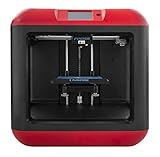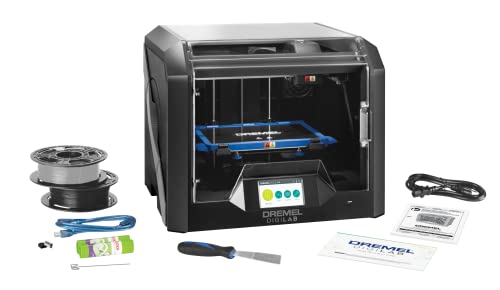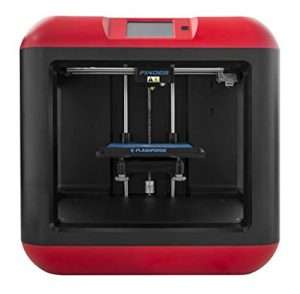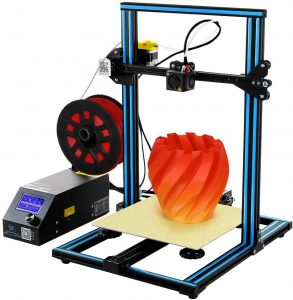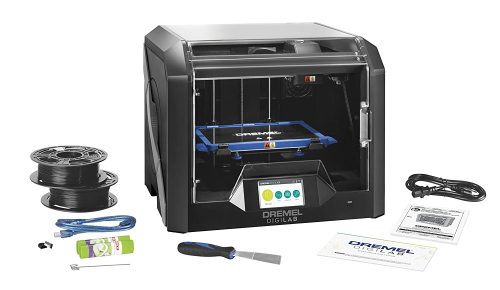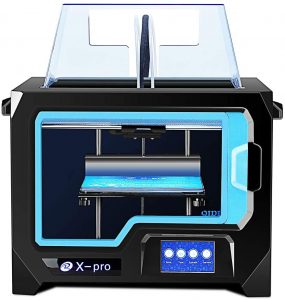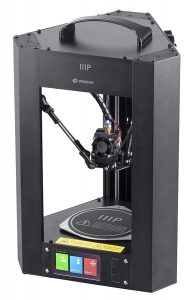- Last Updated: January 12, 2024
One of the best things about 3D printers is they allow you to create just about anything that you can imagine.
From animated characters and superheroes to toys and gadgets, your child can use a 3D printer to bring all their favorite things to life.
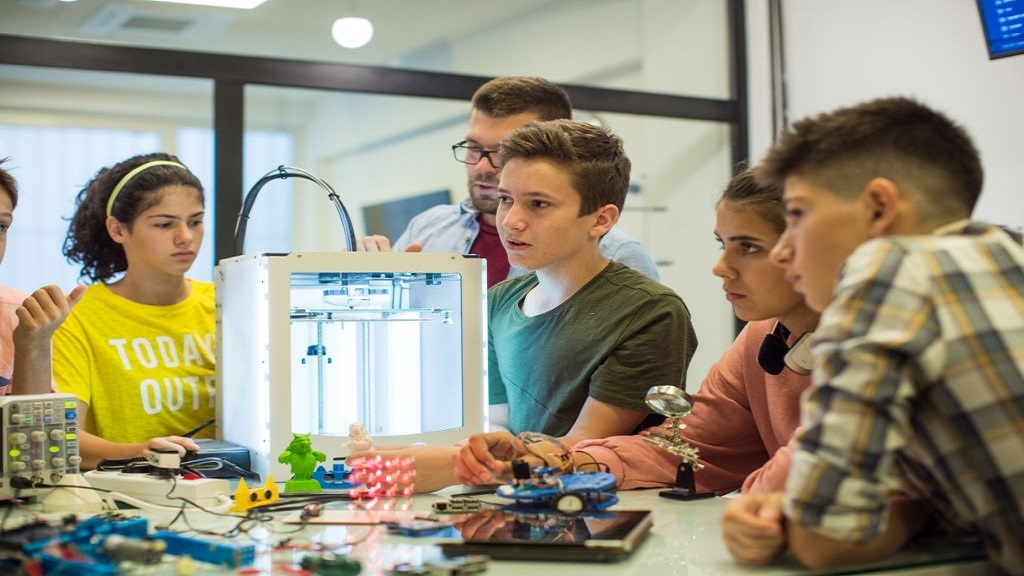
This makes them the perfect gifts for the little ones!
When looking for a 3D printer, you will find several online sources supplying a range of 3D models. It is important to choose one that will pique your child’s curiosity and help their inquisitive mind to learn more as they explore the world.

Build volume: 300 x 300 x 400 mm
That said, the best 3D printers can also be the center of infotainment for your entire family as the grownups can join in the fun with the kids. Without further ado, here are some of the best 3D printers for kids available on the market that you should know about.
Best 3D Printer For Kids At A Glance
Flashforge Finder will appeal to all novices, educators and, of course, kids due to its versatility. The printer has a small footprint, works well and is fairly economical.
At its price point, Flashforge Finder offers a decent list of features that makes this a very competitive product on the market. The model is targeted towards those who are new to the world of 3D printing. The unit especially makes for a fine educational tool for kids. Not only does it offer a fun way to learn difficult concepts, but it can improve children’s creative skills.
With its various features, such as low noise levels, practicality, Wi-Fi connectivity and ease of use, available at a low price tag, the Finder is one of the best choices for newcomers to the 3D field and adequate for those looking for a great 3D printer for kids. Even advanced users looking for a budget 3D printer can find many features of value in this model.
Flashforge Finder comes with a wide array of technologies and high-tech functions in a compact frame, making the unit convenient and aesthetically-pleasing for users.
Every axis on the Finder has a length of 5.5 inches or 140 mm available for it. You can insert and remove the print bed easily. Although you cannot create very big objects with this printer, the maximum size is still decent considering that the model has dimensions of 16.5 in x 16.5 in x 16.5 in.
For printing material, you can deploy polylactic acid, which is both biodegradable and non-toxic. The unit is designed for this material alone. Sole reliance on this material eliminates the need for a heated print bed that requires toxic materials, such as ABS.
Since there are no toxic fumes, the printer is perfect for the home environment and safe for your kids. The optimal build platform is equipped with two spools for printing different types of objects.
Pros
- Excellent print quality
- Good value for money
- Supports Wi-Fi and USB 2.0 connectivity
- Operates quietly
Cons
- Prints polylactic acid filament objects only
- Very fine details may not come out perfectly
The CR-10S is another fine choice for those seeking a budget-friendly and feature-rich 3D printer. The model delivers exceptional print quality at its price range that matches the performance of high-end and more expensive models. Its printing capabilities and functionalities are impressive. For instance, it comes with a generous build size and a filament sensor that can detect empty rolls.
Being a feature-rich machine, the CR-10S is geared towards advanced users. Kids may be able to see this machine in action under adult supervision. For DIY-style tinkering, you can surf through online forums that offer tips and tricks that you can implement on this nifty device.
Creality CR-10S performs very well on its default settings and can print solid structures in both ABS and PLA. Even on the toughest tests, the printer can work well and create objects with minimal issues. You can get a good level of definition with this unit that is decent at its price tag. But, keep in mind that small faults like slight aberrations are visible only upon close scrutiny and a cursory glance at the model produced by the printer will show almost no difference when compared with a model produced by other high-end printers.
Even intricate structures that can be very challenging to make on good quality 3D printers come out with great detail and smooth texture, like the spiral bridge and the Eiffel Tower.
The assembly of the printer is not perfectly straightforward. You will have to refer to the detailed instructions provided on the printed user manual and SD card. You can switch the filament easily, although it is not automatic. Setting up the filament requires some dexterity and a few tries to get it right.
One thing lacking in this otherwise great unit is the lack of wireless connectivity. You will have to make do with an SD card or USB cable. Although this is not a deal-breaker, it is worth noting.
The display shows you useful information like percentage completion, the time elapsed and other important details during the printing process.
At 300 mm x 300 mm x 400 mm, the unit’s build area is massive, allowing you to build large objects. Since the extruder can reach temperatures up to 260 degrees Celsius, you can use different filaments like PETG, wood fill, TPU, PLA and ABS.
Pros
- Economical
- Good print quality
- Easy assembly
- Intuitive interface
- Suitable for bigger prints
Cons
- Filament can get tangled at times
The 3D40 is one of the best high-end 3D printers that you can get if high quality prints are a top priority for you. You need to be aware of one caveat, though. With this unit, you are limited to proprietary filaments that are not exactly economical.
Whether you want a top printer for an educational setting or the home environment, Dremel Digilab 3D40 has a good selection of features, high resolution and flexibility that will suit you well.
The 3D printer unit itself has a smart and clean interface, thanks to the silver and blue color combination that is visually appealing. The print area is fully enclosed with a transparent panel at the front to keep hot and moving parts beyond the reach of children. However, you will still enjoy good visibility and follow all the action as it happens. Sadly, there is no locking mechanism. You will have to supervise children using this machine.
There is no doubt that users will be impressed with the fine quality and intricate details of the finished prints. Both the Best and Standard print modes provide exceptional quality, which is breathtaking and a joy to behold. Even the most demanding 3D printer users will admire the final quality of the solid printouts produced by this unit. Additionally, there is not much finishing work that you need to perform – the final products have minimal bits and filaments that need removal.
The printer passes the toughest tests with flying colors. Where other printers may flounder and struggle, this printer excels. For instance, complex printouts, such as planetary gear systems and human sculptures, come out practically flawless in this.
Another strong point of the 3D40 is the speed of printing. You can get high quality prints in no time. The software also boasts user-friendliness, making it perfect for classrooms and kids. The printing process is trouble-free and simple. Above all, the noise level is low.
The only major downside of this unit is its dependence on proprietary filaments. You cannot use food-safe materials or other materials that are tougher or more flexible.
Pros
- Excellent finishing and dimensional accuracy
- Good printing speed
- Low noise
- Easily removable print bed
- Visually appealing construction
Cons
- Uses only proprietary filaments
The QIDI X-Pro is a versatile dual extrusion 3D printer that is feature-rich yet affordable. This fused deposition modeling printer will attract hobbyists and professionals alike. At its price tag, the QIDI X-Pro is one of the most economical dual extrusion 3D printers that you will find on the market.
The dual extrusion system is capable of using PETG, ABS and PLA as a filament material for its high standard printouts.
The printer unit has fully transparent acrylic covers all around itself so you and your kids can enjoy a high level of visibility while printing is underway. The unit itself is sturdy and compact, making it ideal for home use. The machine does not have any loose cables on the outside that may interrupt the printing process.
The build volume is, however, 230x150x150 mm, which is fairly small. However, the printout quality of objects is very decent. 3D printed objects come out with good dimensional accuracy and acceptable texture. While the dimensional accuracy may be flawless, the textures can be a little rough in certain areas. You may have to resort to slower printer speeds to improve textures.
Even on tough tests like the Autodesk Kickstarter test model, the QIDI X-Pro has immaculate accuracy. The details come out nicely, without any bits showing in the final piece. However, there may be slight rippling on some of the surfaces. Although surface finishing won’t exactly be flawless, due to its nearly immaculate dimensional consistency, QIDI X-Pro makes for a fine 3D printer that kids will love.
Another strong point in favor of the unit is its user-friendliness and the ease with which you can set it up. The software and user interface are simple to master, intuitive and easy to use. The software is available for Mac-OS and Windows and it has a rich array of basic and customizable, advanced options.
The USB drive provided in the package has all the tutorial, object and software files that you need to get started. Several features come pre-configured, so you will be able to set up the machine and start using it right away with minimal hassle.
Pros
- Excellent print quality
- Easy machine setup
- Simple to use
- Most economical in double nozzle systems
Cons
- Suitable for small printouts only
With its all-metal frame, Monoprice Mini Delta boasts an impressive build quality. The printer has Wi-Fi connectivity, full-color display, auto bed leveling and a heated build platform. The printer supports PETG, ABS and PLA filaments. With its 120 mm height by 110 mm diameter, this is a useful tool for prototyping.
The model relies on many of the features that made its predecessor an instant hit. This bargain printer is equipped with a 32-bit ARM controller board and an improved Wi-Fi feature.
The print quality is excellent, even though the printing time can be quite long. However, considering the high standard of the printout, the wait is well worth it. For standard printing tests, the results are nothing short of phenomenal even on default settings. Even without additional tuning, it is hard to find faults in either dimension or texture of the printout.
Thanks to such amazing quality prints at such a low price tag, the Mini Delta stands out as a 3D printer that gives you the best value for money.
The interface comprises three buttons together with a crisp and bright full-color screen. The UI is intuitive, user-friendly and polished. You can set up the Wi-Fi feature easily. The user interface offers simple options for placing the G-code, setting temperatures for the bed and hotend, as well as starting and stopping the print. Beginners can start using this printer right away.
The mobile app is available on iTunes and Play Store. With the app installed, you can configure the 3D printer easily and connect it to your home network. You are then ready to control your 3D printer using your smartphone.
The only downsides of this fantastic printer are the small size and slow printing speeds. Otherwise, it is hard to argue against it considering the extraordinary quality of the finished printouts at this price range.
Pros
- Amazing value for money- the best by far
- Excellent quality prints
- Easy to use interface
- Wi-Fi connectivity and smartphone app
Cons
- Can make only small printouts
Conclusion
Now that you are aware of a fine range of affordable and high quality 3D printers available, you and your kids can spend time together printing anything from the comfort of your home. Of course, you will have to supervise them. But nothing beats the flexibility, power and creativity that these incredible devices put in your hands.
There is no doubt that your children will be thrilled by these exciting 3d printers. In fact, they will remain happily preoccupied with their printer for hours while learning important new things and sparing you mischief. These nifty devices can inspire the scientist in your child and may be the first step in their journey towards the fascinating world of science and technology.




